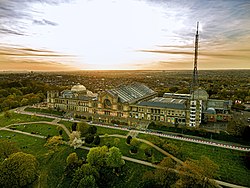
Back Alexandra Palace Afrikaans Alexandra Heall ANG قصر الكسندرا ARZ Аляксандра-палац Byelorussian Alexandra Palace Breton Alexandra Palace Catalan کۆشکی ئەلێکساندرا CKB Alexandra Palace German Alexandra Palace Spanish Alexandra Palace Basque
 Alexandra Palace (2021) | |
 | |
| Location | Alexandra Park, London, N22 |
|---|---|
| Coordinates | 51°35′39″N 00°07′51″W / 51.59417°N 0.13083°W |
| Public transit | |
| Operator | Alexandra Park and Palace Charitable Trust |
| Capacity | 800 (Panorama Room) 1,750 (East Hall/Ice Rink) 2,000 (Palm Court) 2,500 (West Hall) 10,250 (Great Hall) 900 (seated)/1,300 (seated/standing) (Theatre) |
| Construction | |
| Broke ground | September 1865 |
| Opened | 1 May 1875 |
| Renovated | 1873–75, 1980–88, 2016–17 |
| Construction cost | £417,000 (£50.4 million in 2023 pounds[1]) |
| Architect | Owen Jones, John Johnson and Alfred Meeson |
| Builder | Kelk and Lucas |
| Website | |
| Official website | |
Building details | |
 | |
| General information | |
| Inaugurated | 24 May 1873 |
Alexandra Palace is an entertainment and sports venue in North London, situated between Wood Green and Muswell Hill in the London Borough of Haringey. A Grade II listed building,[2] it is built on the site of Tottenham Wood and the later Tottenham Wood Farm.[3] Originally built by John Johnson and Alfred Meeson, it opened in 1873 but following a fire two weeks after its opening, was rebuilt by Johnson. Intended as "The People's Palace" and often referred to as "Ally Pally", its purpose was to serve as a public centre of recreation, education and entertainment; North London's counterpart to the Crystal Palace in South London.[4]
At first a private venture, in 1900, the owners planned to sell it and Alexandra Park for development. A group of neighbouring local authorities managed to acquire it. An Act of Parliament created the Alexandra Palace and Park Trust. The Act required the trustees to maintain the building and park and make them available for the free use and recreation of the public forever. The present trustee is the London Borough of Haringey, whose coat of arms shows lightning bolts depicting Alexandra Palace's pioneering role in the development of television.
In 1935, the trustees leased part of the Palace to the BBC for use as the production and transmission centre for their new television service. In 1936, it became the home of the BBC's first regular public television service. The broadcasting system was 405-line monochrome analogue television – the first fully electronic television system to be used in regular broadcasting. Although other facilities soon superseded it after the Second World War, Alexandra Palace continued to be used by the BBC for many years and its radio and television mast is still in use.
The original studios 'A' and 'B' still survive in the southeast wing with their producers' galleries and are used for exhibiting original historical television equipment. The original Victorian Alexandra Palace Theatre with its stage machinery also survives and as of 2019, is back in use. The theatre and stage structure is on English Heritage's Buildings at Risk register. Alexandra Palace became a listed building in 1996,[2] at the instigation of the Hornsey Historical Society. A planned commercial development of the building into a mixed leisure complex including a hotel, replacement ice-skating rink, cinema, ten-pin bowling alley and exhibition centre, encountered opposition from public groups and was blocked by the High Court in 2007.
The Great Hall and West Hall are typically used for exhibitions, music concerts, and conferences, operated by the trading arm of the charitable trust that owns the building and park on behalf of the public. There is also a pub, ice rink, palm court, and a panoramic view of central London.
In 2013, Alexandra Park was declared a local nature reserve and is also a Site of Borough Importance for Nature Conservation, Grade 1.[5][6][7]
The nearest railway stations are the Alexandra Palace with Great Northern services from Moorgate and London Underground station Wood Green on the Piccadilly line. Alexandra Palace is also served by London Buses route W3.
- ^ UK Retail Price Index inflation figures are based on data from Clark, Gregory (2017). "The Annual RPI and Average Earnings for Britain, 1209 to Present (New Series)". MeasuringWorth. Retrieved 7 May 2024.
- ^ a b Historic England. "Alexandra Palace including former Alexandra Palace Station to North (1268256)". National Heritage List for England. Retrieved 3 November 2011.
- ^ "Alexandra Park Conservation & Heritage Management Plan" (PDF). Alexandra Park and Palace Charitable Trust. January 2011. Archived from the original (PDF) on 13 June 2018. Retrieved 13 June 2018.
- ^ O'Connor, John J. (17 November 1986). "TV Reviews; Film Celebrates BBC's 50th Birthday". The New York Times. Archived from the original on 19 January 2023. Retrieved 8 July 2011.
- ^ "Alexandra Park". Local Nature Reserves. Natural England. 20 March 2014. Archived from the original on 13 April 2014. Retrieved 9 April 2014.
- ^ "Alexandra Park". Greenspace Information for Greater London. 2013. Archived from the original on 13 April 2014. Retrieved 9 April 2014.
- ^ "iGiGL data portal (map)". Greenspace Information for Greater London. Archived from the original on 14 January 2014. Retrieved 9 April 2014.